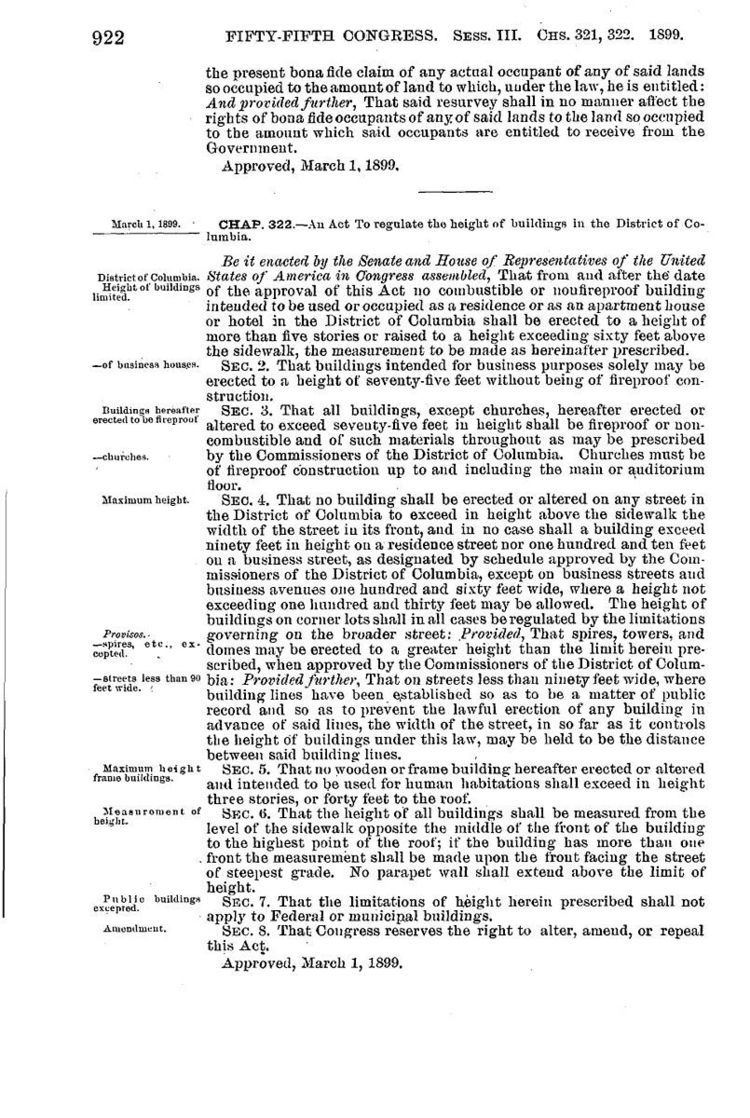 | ||
The Height of Buildings Act of 1899 was a U.S. height restriction law passed by the 55th Congress in response to advancements in construction technology, specifically the use of iron and steel frames, along with thin veneer facades, which made it possible to build lighter, and consequently much taller buildings. Residents of densely populated cities, including Washington D.C., felt that the new technology was untested and steel-framed structures may suffer “serious and fatal defects” due to corrosion from steam pipes and electrical wiring – another relatively recent advancement. They believed that these new tall buildings would ultimately collapse. In an 1899 Senatorial Report, Senator Warren Curtis speculated that, “the life of these structures might not be more than seventy-five years.”
Contents
Another concern was the difficulty of extinguishing fires in the upper floors of tall buildings. At the time, firefighting equipment had been designed to fight flames primarily in low-rise buildings. The growing popularity of skyscrapers presented a new fire hazard. In his report, Senator Curtis wrote that, “It would seem that the fire chiefs in the large cities who have had experience with high buildings are agreed that it is absolutely impossible for them to successfully fight flames over 85 feet (26 m) above the ground with the fire apparatus now manufactured, as the pressure is so great that no hose now made can stand the strain and the men are unable to handle the hose.”
In response to these concerns, on March 1, 1899, United States Congress approved the Act to Regulate the Height of Buildings in the District of Columbia, or more commonly referred to as the Height of Buildings Act of 1899. The law limited the heights of new buildings based on building use and type of construction:
Be it enacted by the Senate and House of Representatives of the United States Of America in Congress assembled,The Height of Buildings Act of 1899 was later amended by the Height of Buildings Act of 1910.
Structural corrosion and limitations of inadequate firefighting equipment are less of a concern today than at the turn of the century, and many major U.S. cities updated their zoning laws to reflect advancements in building technology. For example, the 1961 New York City zoning resolution used a Floor Area Ratio, rather than a height restriction, and allowed for taller buildings when an adjacent public space was provided on the site. Yet, in Washington D.C. subsequent zoning laws followed the precedent set by the 1899 Act, and limited buildings to lower heights. As a result, the skyline of Washington D.C. lacks skyscrapers, and is much lower than that of other major U.S. cities.
The Height-of-the-Capitol-Building Myth
In a 2006 article published in The Washington Post, staff writer Michael Grunwald alluded to the popular belief that the building height restriction in Washington D.C. was originally based on the height of the U.S. Capitol Building. Referring to the Height of Buildings Act of 1899, he wrote, “The original law limited buildings to the height of the Capitol.” The belief has been further perpetuated by The American Surveyor Magazine, as well as the city's residents. In an article aimed at dispelling the myth that zoning laws in the District are currently bound to the height of the Capitol building, the blog We Love DC maintained that, "the 1899 Height of Buildings Act established that no building could be taller than the Capitol (289 feet [88 m])."
Although the belief that buildings in Washington D.C. are currently, or were at one time, restricted to the height of the U.S. Capitol building remains popular to this day, it is untrue, and has even become "the stuff of local lore.” The House of Representatives Report from December 1898, along with the Senate Report from the following year, show that when the bill to restrict the height of buildings was debated on the floor of Congress, no mention had been made of the U.S. Capitol building, or the height of its dome. None of the related House and Senate bills, or the Height Act itself made any mention of the Capitol building. Instead, the law set the maximum height of any building to 130 feet (39.6 m), the height limit that firefighting equipment could effectively reach at the time, and not the 289 feet (88 m) of the Capitol building, as perpetuated by the myth.
